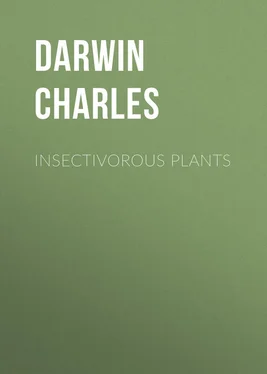Charles Darwin - Insectivorous Plants
Здесь есть возможность читать онлайн «Charles Darwin - Insectivorous Plants» — ознакомительный отрывок электронной книги совершенно бесплатно, а после прочтения отрывка купить полную версию. В некоторых случаях можно слушать аудио, скачать через торрент в формате fb2 и присутствует краткое содержание. Жанр: foreign_antique, foreign_prose, на английском языке. Описание произведения, (предисловие) а так же отзывы посетителей доступны на портале библиотеки ЛибКат.
- Название:Insectivorous Plants
- Автор:
- Жанр:
- Год:неизвестен
- ISBN:нет данных
- Рейтинг книги:5 / 5. Голосов: 1
-
Избранное:Добавить в избранное
- Отзывы:
-
Ваша оценка:
- 100
- 1
- 2
- 3
- 4
- 5
Insectivorous Plants: краткое содержание, описание и аннотация
Предлагаем к чтению аннотацию, описание, краткое содержание или предисловие (зависит от того, что написал сам автор книги «Insectivorous Plants»). Если вы не нашли необходимую информацию о книге — напишите в комментариях, мы постараемся отыскать её.
Insectivorous Plants — читать онлайн ознакомительный отрывок
Ниже представлен текст книги, разбитый по страницам. Система сохранения места последней прочитанной страницы, позволяет с удобством читать онлайн бесплатно книгу «Insectivorous Plants», без необходимости каждый раз заново искать на чём Вы остановились. Поставьте закладку, и сможете в любой момент перейти на страницу, на которой закончили чтение.
Интервал:
Закладка:
Three leaves were placed in water which was heated rather quickly, and by the time the temperature rose to 115o-116o (46o.1 to 46o.06 Cent.), all three were inflected. I then removed the lamp, and in a few minutes every single tentacle was closely inflected. The protoplasm within the cells was not killed, for it was seen to be in distinct movement; and the leaves, having been left in cold water for 20 hrs., re-expanded. Another leaf was immersed in water at 100o (37.7 °Cent.), which was raised to 120o (48o.8 Cent.); and all the tentacles, except the extreme marginal ones, soon became closely inflected. The leaf was now placed in cold water, and in 7 hrs. 30 m. it had partly, and in 10 hrs. fully, re-expanded. On the following morning it was immersed in a weak solution of carbonate of ammonia, and the glands quickly became black, with strongly marked aggregation in the tentacles, showing that the protoplasm was alive, and that the glands had not lost their power of absorption. Another leaf was placed in water at 110o (43o.3 Cent.) which was raised to 120o (48o.8 Cent.); and every tentacle, excepting one, was quickly and closely inflected. This leaf was now immersed in a few drops of a strong solution of carbonate of ammonia (one part to 109 of water); in 10 m. all the glands became intensely black, and in 2 hrs. the protoplasm in the cells of the pedicels was well aggregated. Another leaf was suddenly plunged, and as usual waved about, in water at 120o, and the tentacles became inflected in from 2 m. to 3 m., but only so as to stand at right angles to the disc. The leaf was now placed in the same solution (viz. one part of carbonate of ammonia to 109 of water, or 4 grs. to 1 oz., which I will for the future designate as the strong solution), and when I looked at it again after the interval of an hour, the glands were blackened, and there was well-marked aggregation. After an additional interval of 4 hrs. the tentacles had become much more inflected. It deserves notice that a solution as strong as this never causes inflection in ordinary cases. Lastly a leaf was suddenly placed in water at 125o (51o.6 Cent.), and was left in it until the water cooled; the tentacles were rendered of a bright red and soon became inflected. The contents of the cells underwent some degree of aggregation, which in the course of three hours increased; but the masses of protoplasm did not become spherical, as almost always occurs with leaves immersed in a solution of carbonate of ammonia.]
We learn from these cases that a temperature of from 120o to 125o (48o.8 to 51o.6 Cent.) excites the tentacles into quick movement, but does not kill the leaves, as shown either by their subsequent re-expansion or by the aggregation of the protoplasm. We shall now see that a temperature of 130o (54o.4 Cent.) is too high to cause immediate inflection, yet does not kill the leaves.
[Experiment 1. – A leaf was plunged, and as in all cases waved about for a few minutes, in water at 130o (54o.4 Cent.), but there was no trace of inflection; it was then placed in cold water, and after an interval of 15 m. very slow movement was distinctly seen in a small mass of protoplasm in one of the cells of a tentacle. 12 12 Sachs states ('Trait de Botanique,' 1874, p. 855) that the movements of the protoplasm in the hairs of a Cucurbita ceased after they were exposed for 1 m. in water to a temperature of 47o to 48 °Cent., or 117o to 119o Fahr.
After a few hours all the tentacles and the blade became inflected.
Experiment 2. – Another leaf was plunged into water at 130o to 131o, and as before there was no inflection. After being kept in cold water for an hour, it was placed in the strong solution of ammonia, and in the course of 55 m. the tentacles were considerably inflected. The glands, which before had been rendered of a brighter red, were now blackened. The protoplasm in the cells of the tentacles was distinctly aggregated; but the spheres were much smaller than those generated in unheated leaves when subjected to carbonate of ammonia. After an additional 2 hrs. all the tentacles, excepting six or seven, were closely inflected.
Experiment 3. – A similar experiment to the last, with exactly the same results.
Experiment 4. – A fine leaf was placed in water at 100o (37o.7 Cent.), which was then raised to 145o (62o.7 Cent.). Soon after immersion, there was, as might have been expected, strong inflection. The leaf was now removed and left in cold water; but from having been exposed to so high a temperature, it never re-expanded.
Experiment 5. – Leaf immersed at 130o (54o.4 Cent.), and the water raised to 145o (62o.7 Cent.), there was no immediate inflection; it was then placed in cold water, and after 1 hr. 20 m. some of the tentacles on one side became inflected. This leaf was now placed in the strong solution, and in 40 m. all the submarginal tentacles were well inflected, and the glands blackened. After an additional interval of 2 hrs. 45 m. all the tentacles, except eight or ten, were closely inflected, with their cells exhibiting a slight degree of aggregation; but the spheres of protoplasm were very small, and the cells of the exterior tentacles contained some pulpy or disintegrated brownish matter.
Experiments 6 and 7. – Two leaves were plunged in water at 135o (57o.2 Cent.) which was raised to 145o (62o.7 Cent.); neither became inflected. One of these, however, after having been left for 31 m. in cold water, exhibited some slight inflection, which increased after an additional interval of 1 hr. 45 m., until all the tentacles, except sixteen or seventeen, were more or less inflected; but the leaf was so much injured that it never re-expanded. The other leaf, after having been left for half an hour in cold water, was put into the strong solution, but no inflection ensued; the glands, however, were blackened, and in some cells there was a little aggregation, the spheres of protoplasm being extremely small; in other cells, especially in the exterior tentacles, there was much greenish-brown pulpy matter.
Experiment 8. – A leaf was plunged and waved about for a few minutes in water at 140o (60 °Cent.), and was then left for half an hour in cold water, but there was no inflection. It was now placed in the strong solution, and after 2 hrs. 30 m. the inner submarginal tentacles were well inflected, with their glands blackened, and some imperfect aggregation in the cells of the pedicels. Three or four of the glands were spotted with the white porcelain-like structure, like that produced by boiling water. I have seen this result in no other instance after an immersion of only a few minutes in water at so low a temperature as 140o, and in only one leaf out of four, after a similar immersion at a temperature of 145o Fahr. On the other hand, with two leaves, one placed in water at 145o (62o.7 Cent.), and the other in water at 140o (60 °Cent.), both being left therein until the water cooled, the glands of both became white and porcelain-like. So that the duration of the immersion is an important element in the result.
Experiment 9. – A leaf was placed in water at 140o (60 °Cent.), which was raised to 150o(65o.5 Cent.); there was no inflection; on the contrary, the outer tentacles were somewhat bowed backwards. The glands became like porcelain, but some of them were a little mottled with purple. The bases of the glands were often more affected than their summits. This leaf having been left in the strong solution did not undergo any inflection or aggregation.
Experiment 10. – A leaf was plunged in water at 150o to 150 1/2o (65o.5 Cent.); it became somewhat flaccid, with the outer tentacles slightly reflexed, and the inner ones a little bent inwards, but only towards their tips; and this latter fact shows that the movement was not one of true inflection, as the basal part alone normally bends. The tentacles were as usual rendered of a very bright red, with the glands almost white like porcelain, yet tinged with pink. The leaf having been placed in the strong solution, the cell-contents of the tentacles became of a muddy-brown, with no trace of aggregation.
Читать дальшеИнтервал:
Закладка:
Похожие книги на «Insectivorous Plants»
Представляем Вашему вниманию похожие книги на «Insectivorous Plants» списком для выбора. Мы отобрали схожую по названию и смыслу литературу в надежде предоставить читателям больше вариантов отыскать новые, интересные, ещё непрочитанные произведения.
Обсуждение, отзывы о книге «Insectivorous Plants» и просто собственные мнения читателей. Оставьте ваши комментарии, напишите, что Вы думаете о произведении, его смысле или главных героях. Укажите что конкретно понравилось, а что нет, и почему Вы так считаете.












